Abstract
Many scholars have argued that the act of performance, as a “reading” of a musical text, can serve as a form of analysis. This paper argues that the act of transcribing a musical text for a different group of instruments also constitutes a “reading,” and that both processes of translation will inevitably shed light on certain features of a work while obscuring others. To illustrate, the paper considers transcriptions of Bach’s chorale “Wachet auf” by Leopold Stokowski, Sir Granville Bantock, and Ottorino Respighi, and demonstrates that these translations represent three very different readings and interpretations of Bach’s text which collectively shed light on the work’s meaning.
Each transcription proposes a different reading of the relationship between Nicolai’s tune and Bach’s setting. Stokowski casts Bach’s contrapuntal setting as an ornamentation of Nicolai’s original chorale melody, which he regards as the work’s centerpiece; Bantock treats the chorale melody as merely a foundation upon which to build a new musical edifice, adding his own newly composed counterpoint to Bach’s setting; and Respighi undertakes a more holistic reading of the work, acknowledging both Nicolai’s and Bach’s contributions while focusing on Bach’s setting as a whole. These three transcribers also illuminate different aspects of the work’s form. Whereas Bantock and Respighi adhere to the bipartite form of Bach’s setting, albeit with subtle and compelling modifications by Respighi, Stokowski reveals a latent tripartite form; by omitting the repeat of the opening A section, he proposes a minor-mode B section followed by a modified recapitulation.
The relationship between performance and analysis is an important topic in music theory today. Although much of the discussion has focused on ways in which analysis can inform performance, it has also been suggested that the act of performance itself can serve as a form of analysis. One of the more eloquent arguments in favor of this view was put forth nearly half a century ago by David Lewin:
Whatever the use to which analysis is put . . . , its goal is simply to hear the piece better, both in detail and in the large. The task of the analyst is “merely” to point out things in the piece that strike him as characteristic and important . . . , and to arrange his presentation in a way that will stimulate the musical imagination of his audience. . . . Hence, the only complete, faithful, and properly presented analyses of a piece are . . . (various) legitimate performances of it.1
Though Lewin goes on to acknowledge that “verbal analyses, while inevitably partial and distorted, are very useful,” his point is well worth considering.2 If we accept Lewin’s position that the goal of analysis is “to hear the piece better,” then the medium of sound is surely the most direct way of communicating analytical insights. And if performance is an effective means of making analytical claims, then it should likewise be an effective means of critiquing them. This is the point that Joel Lester makes when he asks rhetorically “for what power can an analytical assertion carry if clearly contradicted by a performance which is widely accepted as ‘effective?’”3 For Lester, a considered performance is just as valid an “analysis” of a work as a conventional analysis and should not be dismissed out of hand.
Implicit in both Lewin’s and Lester’s arguments is the notion that a performance cannot help but comment analytically on the work, whether consciously or unconsciously. After all, performers are in the business of “pointing out things in the piece that strike them as characteristic and important,” things that contribute to an “effective” performance. A performer is not simply a reproducing machine. The act of performance has more to do with interpreting the work than with reproducing it, to which the enormous variety of “effective” performances of a given work will attest.
The relationship I am describing between musical work and performer is not unlike the relationship between text and reader as described by the late literary theorist Wolfgang Iser. Iser characterized the act of reading in this way: “the message is transmitted in two ways, so that the reader ‘receives’ it by composing it. . . . The interpreter’s task should be to elucidate the potential meanings of a text, and not restrict himself to just one.”4 Far from regarding the text as an object with a fixed meaning that has merely to be “discovered” by the reader, Iser cast the relationship between text and reader as something more akin to a dialogue, or a feedback loop, in which both text and reader contribute importantly to a work’s meaning.
Iser’s theory of reader response provides us with an apt model of a performer’s interaction with a musical score. In effect, we can understand a performer as a “reader” of a musical “text,” and this act of reading and subsequently interpreting the text cannot reasonably be said to constitute just one-way communication from composer to performer. On the contrary, Fig. 1 illustrates that both composer and “reader” contribute importantly and creatively to the meaning of a musical text, and it follows that we gain understanding of a musical work by consideration of its various potential readings.

Figure 1. Wolfgang Iser’s characterization of the “reader” as co-author of the work’s meaning.
Of course, a performer’s task is not merely to read and interpret a musical score, but also to translate it into a new medium in a feat akin to what Roman Jakobson has dubbed “intersemiotic translation” or “transmutation.”5 Though Jakobson defines this as “an interpretation of verbal signs by means of signs of non-verbal sign systems,” the concept can be applied to any translation of meaning from one medium to another. The translation of a musical text’s received meaning into the medium of sound is exceedingly complex and constitutes a crucial step in the performer’s creative contribution to a work’s meaning.
Though performance is certainly one way to “read” a musical text and conventional analysis is another, I take the view that the act of transcribing a musical text for a different group of instruments also constitutes a “reading.” Moreover, like a performance, a transcription also constitutes a “translation” of the text. A performance translates a musical text into the medium of sound, while a transcription translates it into a different instrumental palette. Thus, whereas performance constitutes a kind of “intersemiotic translation,” transcription may be described as a form of what Jakobson calls “interlingual translation,” or “translation proper,” since both the transcriber’s original “text” and the resulting “translation” dwell within the same medium, that of the musical score.6 Both processes of translation involve making interpretive decisions. In the case of the performer, these decisions are wide ranging, affecting dynamics, tempi, articulations, phrasing—the list goes on. The transcriber must also make many of these same decisions, and adds to them considerations such as instrumentation and texture.
George Steiner has argued that the “hermeneutic motion” inherent in any act of translation results in an “enhancement” of the original text as relationships are formed between it and its various translations.7 Wherever the translation may be judged to be inferior to the original, by association it makes the original’s strengths “more precisely visible.” Likewise, wherever the translation proves greater than the original, it “infers that the source-text possesses potentialities, elemental reserves as yet unrealized by itself.”8
Thus, both performer and transcriber contribute significantly to a musical text’s meaning in their roles as reader and translator. Whether conscious or unconscious, the interpretive choices they make inevitably highlight certain aspects of the work while obscuring others. The highlighted features are those that the “reader” finds “characteristic and important,” to use Lewin’s phrase, and by drawing our attention to these features the performer or transcriber is changing the way we hear the work. Furthermore, through the process of translation, features not apparent in the original may become emphasized, and elements originally salient may be suppressed in importance; far from being merely the result of imperfect attempts to reproduce a fixed original work, the perceptual shifts inevitably introduced by the translation process both allow and encourage us to rediscover the work and gain a deeper understanding of its makeup.
Many composers’ works have been transcribed for ensembles other than those for which they were originally conceived, but probably none as much so as the works of J. S. Bach. One reason for this may be his music’s quintessentially canonic status. Its esteemed position has lent it a long history of pedagogical use. For centuries, young composers have studied and copied his works as they honed their craft, a state of affairs that remains essentially unchanged to this day as evidenced by the continued reliance on Bach chorales as exemplars in early harmony instruction.
However, another and possibly more important reason is the nature of the music itself. His music has proven to be particularly well suited for transcription, due in no small part to the relatively abstract nature of his counterpoint, and the general lack of editorial annotations in his scores has inspired countless imaginative settings of his works.
Of course, transcriptions of Bach’s music are of particular interest because he himself was a great transcriber. He too saw the possibilities for the transcription of his own music, often recycling material repeatedly for different combinations of instruments. He also studied the works of others by transcribing them. Beginning around 1708 with his arrival in Weimar and continuing throughout his life, the composer actively sought to familiarize himself with the works of his contemporaries, including a substantial body of French and Italian music, and he mastered their styles and textures primarily through extensive copying and transcribing. His transcriptions of concerti by Vivaldi and Telemann for harpsichord and organ are especially noteworthy, and many of these nearly qualify as recompositions due to the amount of new material he added to the originals, in some cases radically altering their form.
But arguably Bach’s greatest contribution to the reworking of earlier material lies in the settings of Lutheran chorale melodies. These feature prominently in the passion oratorios and throughout the composer’s sacred cantatas. Moreover, nearly three-quarters of the composer’s works for organ are related to the chorale in some way, and this despite the fact that the art of the organ chorale, once the cornerstone of Lutheran worship, was already in steep decline throughout Bach’s life.
In this paper, I will examine transcriptions of Bach’s most famous setting of the chorale “Wachet auf, ruft uns die Stimme.” The well-known chorale tune is attributed to Philipp Nicolai and is believed to have been composed at the turn of the seventeenth century. In 1731, Bach fashioned three settings of “Wachet auf” for his Cantata No. 140, and it is the second of these, “Zion hört die Wächter singen,” that the composer himself transcribed for organ at the behest of the publisher J. G. Schübler sometime between 1746 and 1750. In both the cantata and organ chorale versions, Bach added two newly composed contrapuntal parts to Nicolai’s original chorale, as well as accompanying bass figures to be realized during performance. As a result, subsequent transcribers of this piece have had the opportunity to comment not only on Bach’s setting as a whole but also on the relationship between Bach’s counterpoint and the original chorale melody itself.
I will examine orchestral transcriptions of this particular setting of “Wachet auf” that date from the first half of the twentieth century by Leopold Stokowski, Sir Granville Bantock, and Ottorino Respighi.9 I will argue that these three translations represent three very different readings and interpretations of Bach’s text; though each transcriber read the same text, each one saw the relationship between Nicolai’s chorale melody and Bach’s setting of it in a strikingly different light, and each perceived the work’s form in a markedly different way.
Arguably one of the most important conductors of the twentieth century, Leopold Stokowski began transcribing Bach’s music for orchestra during his early years as conductor of the Philadelphia Orchestra. Originally an organist, Stokowski lamented the fact that there were so few orchestral works by Bach that he could include in his concert programs. His solution was to transcribe some of the organ works for a large symphony orchestra, and in so doing he introduced Bach’s music to the concert-going and later the record-buying public to an unprecedented extent. Throughout his lifetime, he made over fifty transcriptions of Bach’s works, and while many of these remain unpublished, manuscripts for all can be found in the Stokowski Collection at the University of Pennsylvania.10
Stokowski’s transcription of “Wachet auf” is among his many unpublished transcriptions. Dating from 1940, it features many of the maestro’s hallmarks. The woodwinds, strings, and brass are played against one another to great effect, and stark contrasts of color and texture abound.
Though Stokowski brings much nuance to the setting of Bach’s counterpoint, his primary aim in this transcription seems to be to pit the original chorale melody against Bach’s setting of it. While Stokowski divides Bach’s newly composed counterpoint more or less antiphonally between woodwinds and strings, Ex. 1 shows that he gives the original chorale exclusively to the trumpets and trombones.11
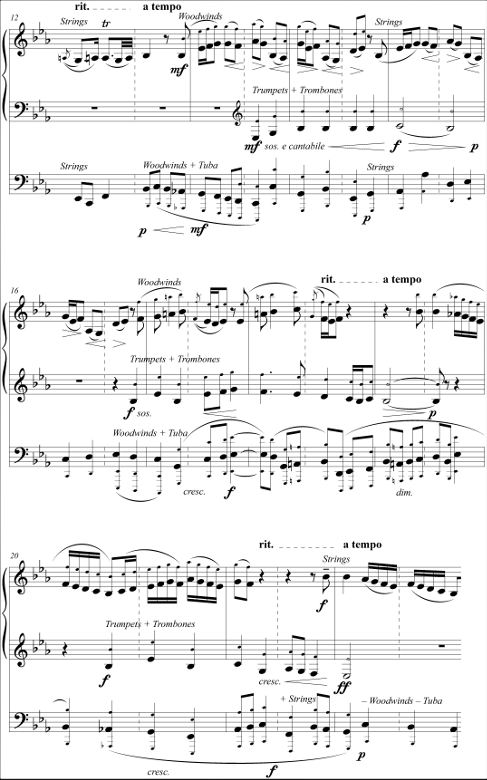
Example 1. Stokowski’s transcription of Bach, “Wachet auf, ruft uns die Stimme,” BWV 645, mm. 12-22. Nicolai’s chorale is given exclusively to the trumpets and trombones, while Bach’s counterpoint is divided antiphonally between woodwinds and strings.
Furthermore, there are indications that it is specifically Nicolai’s great chorale melody that has captivated the maestro’s attention. In particular, Stokowski’s consistent doubling of the tenor melody at the upper octave elevates it greatly in importance. Even though in Bach’s original setting the chorale tune does not entirely avoid crossing the upper contrapuntal line (in m. 17, for example), in Stokowski’s hands it vies with it for the listener’s attention in a much more immediate way, for the chorale tune and the upper contrapuntal line occupy essentially the same registral space throughout the entire setting. Moreover, since the doubling of the upper contrapuntal line is inconsistent in Stokowski’s setting, there are many more instances in which the chorale melody rises above Bach’s counterpoint, with mm. 14-15 providing one example.
Were this the work of a lesser orchestrator, we might be tempted to dismiss these doublings as merely a poor choice of orchestration. However, Stokowski’s exceedingly unorthodox changes of tempo support the notion that he is deliberately pitting the chorale melody against Bach’s setting of it. The end of almost every chorale phrase is accompanied by a significant slowing of the tempo, and in some cases this pronounced slowing flagrantly disregards the phrasing of Bach’s counterpoint. Nowhere is this phrasing dissonance between chorale and counterpoint more obvious than at the end of the chorale’s final phrase, shown in Ex. 2. Here, a dramatic ritenuto (intensified by a simultaneous Allargando) and the ensuing a tempo effectively mark the chorale’s final cadence while simultaneously doing serious violence to the contrapuntal flow of the outer voices.12
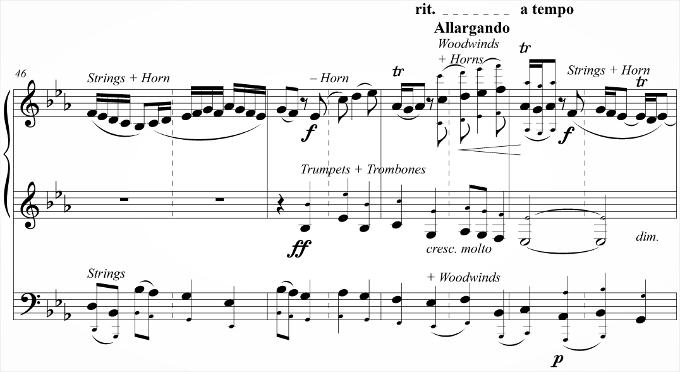
Example 2. Stokowski’s transcription of Bach, “Wachet auf, ruft uns die Stimme,” BWV 645, mm. 46-49. The ritenuto in m. 48, while marking the end of the chorale’s final phrase, substantially disrupts the flow of Bach’s contrapuntal line.
As unorthodox, and even unnerving, as Stokowski’s tempo changes may be, his reading viscerally highlights the phrasing misalignment at this moment and others between Nicolai’s melody and Bach’s contrapuntal line, a latent tension between chorale and counterpoint present in Bach’s original. By focusing on the chorale melody and on the way it competes registrally and structurally with Bach’s setting, he brings to our attention a subtle yet important sense of friction between Nicolai and Bach.
Building on the diagram in Fig. 1, we might characterize Stokowski’s reading of the piece as something like the depiction in Fig. 2. First, the diagram acknowledges that Bach’s counterpoint, and by extension his setting as a whole, is itself a reading of Nicolai’s original melodic text. Stokowski’s transcription, on the other hand, is less a reading of Bach’s text as a whole, indicated by the dotted two-way arrow, and more akin to two simultaneous yet separate dialogues with its individual components. These are indicated by solid two-way arrows, and the increased prominence given to the original chorale melody is reflected in the diagram by the increased thickness of that arrow.
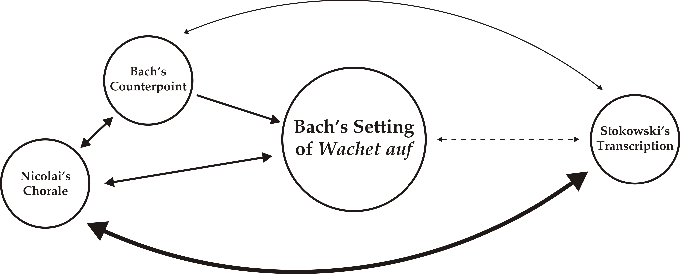
Figure 2. Stokowski’s reading of Bach’s “Wachet auf.” Stokowski focuses on Nicolai’s original chorale melody, highlighting the tension between it and Bach’s contrapuntal setting.
Though the now-forgotten British composer Sir Granville Bantock adopted a similarly romantic reading of Bach’s text, the relationship between chorale and contrapuntal setting in his transcription is quite different. Far from the spotlighting of different instrument groups heard in Stokowski’s arrangement, Bantock weaves a much more uniform instrumental fabric while still maintaining the distinction between chorale melody and contrapuntal setting. In this setting, the chorale is given exclusively to the horns in unison, as seen in Ex. 3, while Bach’s two contrapuntal lines are given to the string section. Even though the horns are marked forte, the lack of any octave doubling confines them to a register from which it is generally difficult for them to project the chorale melody, the result being that the strings easily overpower the horns’ chorale melody in many places.
Undoubtedly the most striking feature of Bantock’s setting is the material introduced by the woodwinds, shown in the example on two additional staves above the three staves of Bach’s organ chorale. To Bach’s setting, Bantock has in fact added his own newly composed parts, loosely motivically related to Bach’s counterpoint, that go well beyond mere harmonization of the existing lines in Bach’s original. Although these woodwind lines blend reasonably well with the rest of the material, the constant background murmuring effected by their persistence throughout the setting serves to further draw attention away from the chorale melody and toward its contrapuntal setting.
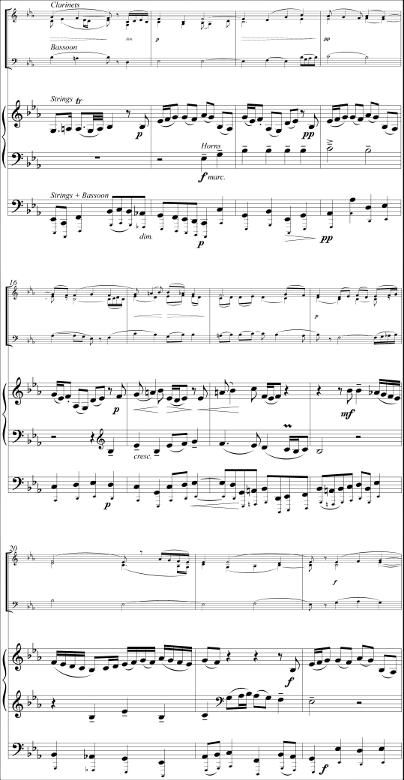
Example 3. Bantock’s transcription of Bach, “Wachet auf, ruft uns die Stimme,” BWV 645, mm. 12-22. The two smaller staves above Bach’s organ chorale contain accompanying material newly composed by Bantock.
Far from being the centerpiece of the work as it was in Stokowski’s reading, Nicolai’s chorale melody becomes merely one of many component parts in Bantock’s setting. For Bantock, the “characteristic and important” features of the work lie not in the tension between chorale and counterpoint, as they do for Stokowski, but rather in the details of the contrapuntal setting itself. Whereas Stokowski sought to foreground the chorale melody and remind the listener of its original autonomy, Bantock acknowledges its distinct identity while at the same time marginalizing its structural importance, effectively burying it in a sea of contrapuntal figuration. Like Fig. 2, Fig. 3 reflects the fact that Bantock regards the chorale and Bach’s contrapuntal setting as largely separate entities, interacting with each independently. But in contrast to Fig. 2, the thick two-way arrows in Fig. 3 reflect the great importance Bantock assigns to the accompanying contrapuntal parts of both Bach’s and his own devising; the chorale, by comparison, he treats as a mere foundation on which to build a new musical edifice.13
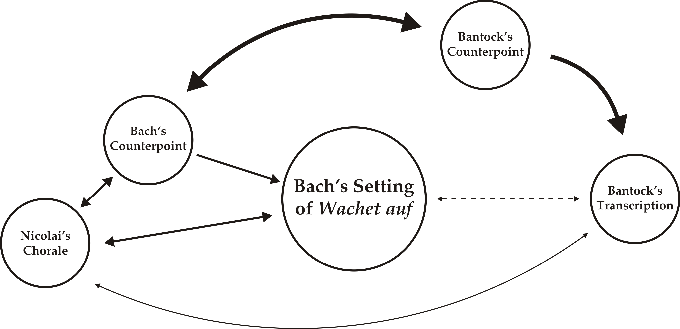
Figure 3. Bantock’s reading of Bach’s “Wachet auf.” Bantock treats Nicolai’s chorale melody as merely the foundation on which to build newly composed counterpoint in addition to Bach’s.
In contrast to the settings of Stokowski and Bantock, which are scored for very large orchestras, the Italian composer Ottorino Respighi approaches “Wachet auf” with considerably more restraint. His orchestra is varied, but modest in size. Known for his lifelong interest in early music, an interest that led to such well-known works as the Ancient Airs and Dances and The Birds, Respighi brings a subtlety and intimacy to the work as only a master orchestrator can, achieving profound effects with the simplest of means.
Unlike Stokowski and Bantock, who both treat the original chorale and Bach’s setting largely independently of one another, Respighi develops a more holistic reading of the text. Admittedly, at the opening there is in fact a clear distinction between chorale and contrapuntal setting; Ex. 4 shows that Bach’s counterpoint is given to the strings while the chorale is introduced first by clarinet and bassoon, with horns joining in subsequent phrases. Notice however that by m. 20 Respighi is already doubling the chorale melody at the lower octave, an interesting reversal of Stokowski’s upper-octave doubling. Rather than bringing the chorale into registral conflict with Bach’s soprano line, Respighi’s doubling maintains the chorale/counterpoint distinction while simultaneously reinforcing the chorale melody, eschewing the suppression of the chorale we witnessed in the Bantock transcription.
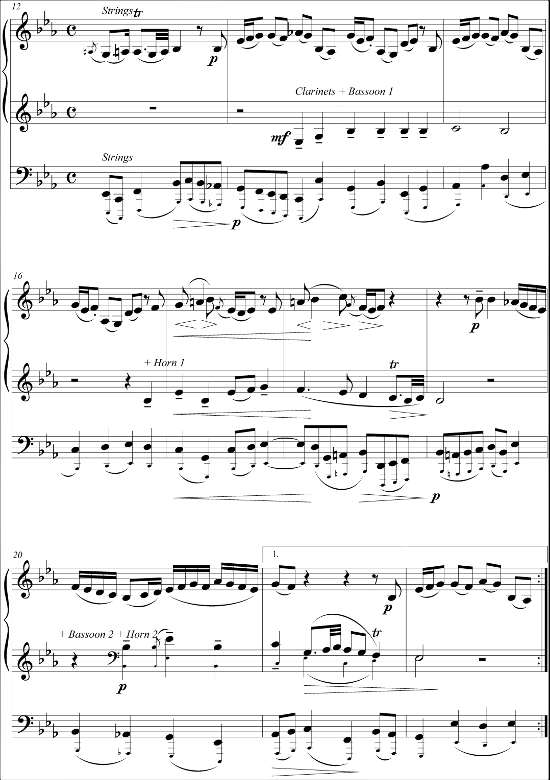
Example 4. Respighi’s transcription of Bach, “Wachet auf, ruft uns die Stimme,” BWV 645, mm. 12-22. Initially, there is a clear distinction between chorale melody and contrapuntal setting.
As the work progresses, the texture gradually thickens, slowly yet inexorably removing the separation between chorale and counterpoint. At first, additional woodwinds and brass join the chorale melody, gradually and subtly harmonizing it. This leads to doubling of the chorale melody at the upper octave beginning with the pickup to m. 30 and corresponding doubling of Bach’s contrapuntal line beginning with the pickup to m. 43. Ex. 5 documents the final step in this process, as the final notes of the harmonized chorale in the winds and brass are extended and merge with a tutti harmonization of the final measures of Bach’s contrapuntal setting, effectively blurring the line between chorale and counterpoint. In these final measures, it is as though the chorale itself reaches out and grasps Bach’s contrapuntal framework, uniting them to form an indivisible whole, and this is indicated by the large arrow in m. 51 of the example.
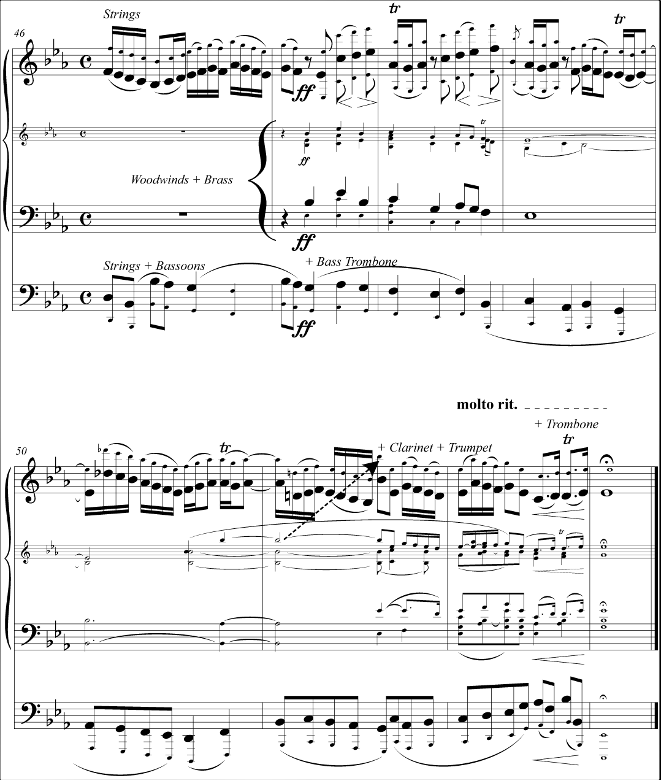
Example 5. Respighi’s transcription of Bach, “Wachet auf, ruft uns die Stimme,” BWV 645, mm. 46-53. The chorale harmonization merges with the contrapuntal setting in the final measures.
By giving more or less equal weight to both Nicolai’s chorale melody and Bach’s counterpoint, and by gradually and skillfully bringing them closer to one another over the course of the piece, Respighi conveys the impression that the two truly belong together, and this is reflected in the design of Fig. 4. Though both chorale and contrapuntal setting are presented distinctly at first, ultimately neither is allowed to overshadow the other, so that in this case the primary dialogue truly is between Respighi and Bach’s text as a whole,
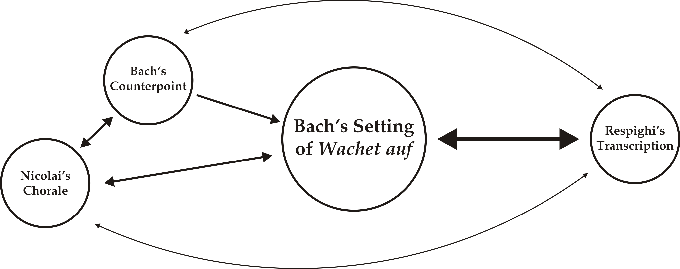
Figure 4. Respighi’s reading of Bach’s “Wachet auf.” Respighi undertakes a more holistic reading of the work, focusing on Bach’s setting as a whole.
indicated by the large two-way arrow in the figure. In this, Respighi’s effort seems to come the closest to realizing what Walter Benjamin famously characterized as the central “task of the translator.” For Benjamin, the ideal translation “is transparent; it does not cover the original, does not block its light, but allows the pure language, as though reinforced by its own medium, to shine upon the original all the more fully.”14 If Respighi’s reading perhaps lacks the strikingly original quality of Stokowski’s and Bantock’s settings, his approach leaves the listener with the impression of a work that is very much more than the sum of its parts.
The fact that three different transcribers developed three substantially different readings of the relationship between Nicolai’s chorale melody and Bach’s accompanying contrapuntal setting is certainly noteworthy. However, it is not entirely surprising to discover this sort of variation amongst transcriptions of this piece, as the distinction between chorale and counterpoint is one of its most basic structural features.
I find it far more surprising that Bantock, Respighi, and Stokowski do not read the work’s form in the same way at all. It is clear that Bach’s original setting divides neatly into two parts; the first part, mm. 1-21, is repeated, while the second part, mm. 22-53, is not. As Table 1 illustrates, there is nothing unusual about Bantock’s reading of the form. His approach is thoroughly literal; he reads a straightforward bipartite form with a repeated opening A section.
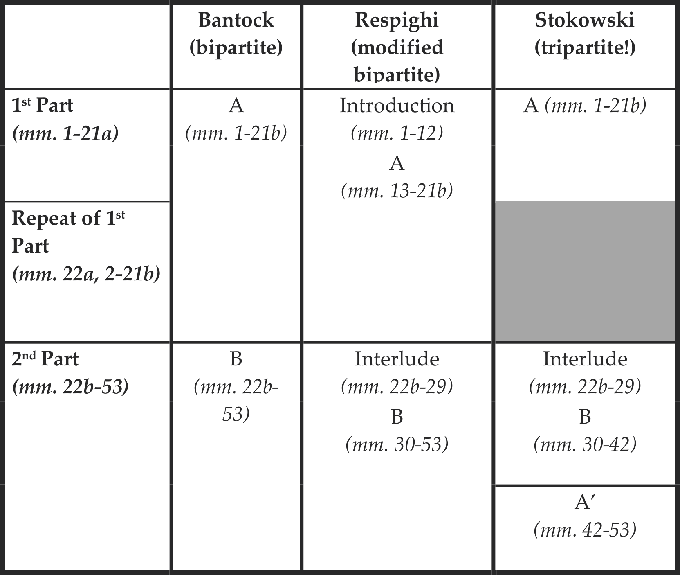
Table 1. Formal differences among the three readings of Bach’s “Wachet auf, ruft uns die Stimme,” BWV 645.
As is the case with other aspects of Respighi’s transcription, his reading of the work’s form is at once more sophisticated and subtle than Bantock’s. Although he too reads the form as essentially bipartite, he initially casts mm. 1-12 as an introduction. The dramatic reduction in dynamic level between mm. 12 and 13, coinciding with the entrance of the chorale, contributes to the perception of an introduction spanning mm. 1-12. However, upon repeating mm. 1-22, the strings are asked to play sotto voce throughout. In this way, with the help of carefully judged dynamics and orchestration, Respighi successfully subsumes the opening measures within a single larger A section. As Table 1 shows, by maintaining a soft dynamic throughout the repeat of mm. 1-22, Respighi encourages us to hear mm. 1-12 differently once the first half of the chorale melody has already been heard; instead of hearing these measures as a repeat of the introduction, we perceive them as a continuation of the A section. When the dynamic level is raised once more in m. 22b, we understand this as a more fundamental structural division, and this interlude paves the way for the chorale’s continuation in the B section, beginning with the pickup to m. 30.
The difference between Bantock’s and Respighi’s formal readings is relatively subtle. However, there is nothing at all subtle about Stokowski’s characterization of the work’s form. Of the three transcriptions under consideration, Stokowski’s is the only one in which the repetition of mm. 1-22 is omitted, shown in Table 1 by the greyed-out area; by omitting this repeat, he drastically alters the work’s proportions, rendering the first section barely half as long as the second. It bears asking what could have motivated Stokowski to truncate the first half of the piece so severely, as well as examining the effect of the apparent formal imbalance that results.
Curiously, the resulting shift in proportion doesn’t feel unbalanced when one listens to the transcription straight through. In order to prevent the second half from seeming overly long compared to the first, Stokowski introduces a startling change of tempo, dynamics, color, and texture concentrated around mm. 33-42. Stokowski marks the modulations to the minor keys of the submediant and mediant with a significant slowing of tempo (marked più tranquillo), lowering of dynamic level, darkening of tonal color, and thinning of orchestral texture. In so doing, he transforms the work’s minor-mode foray into a haunting bassoon solo (marked espressivo), that is more akin to an adagio lamentoso than to the chorale with which we are familiar.
In effect, what Stokowski has managed to do is expand the first portion of the second half into what is to my ear a convincing self-contained B section within a tripartite rather than bipartite structure. It is the perfect authentic cadence in G minor in m. 42 that effects the tonal closure necessary to support the tripartite interpretation. In a moment of cognitive dissonance, despite elevating the chorale tune over Bach’s counterpoint in other respects, it is Stokowski who shows us that the return of Bach’s opening contrapuntal line in m. 43 can serve very effectively as a recapitulation within a tripartite structure, and the return of the work’s original, more familiar sound world at this point reinforces this hearing. In contrast, it is the other two transcribers who adhere much more closely to the bipartite form of the chorale melody itself. In this, Stokowski’s transcription hews most closely to Ezra Pound’s famous exhortation to the translator to “make it new.”15 "As Else Vieira explains, “with Pound, translation is seen as criticism, insofar as it attempts theoretically to anticipate creation, it chooses, it eliminates repetitions, it organizes knowledge in such a way that the next generation may find only the still living part.”16 Thus, in an even more profound way than the registral and phrasing conflicts mentioned previously, Stokowski successfully conveys the tension between chorale and contrapuntal setting, between Nicolai and Bach, that is inherent in Bach’s text, and in so doing discovers and reveals the tripartite form latent in Bach’s setting.
Some years ago, Lawrence Rosenwald remarked that “we come to know [the original] precisely by means of reflecting on its translations.”17 This, I believe, is what makes the art of transcription an invaluable analytical tool, as invaluable as performance art.
In recent decades, the practice of transcribing Bach’s music for the modern orchestra has very much fallen out of fashion, an aesthetic shift that has accompanied the increased emphasis on authentic performance practice and the rise of period instrument ensembles. As a result, today’s listeners and scholars may understandably find transcriptions such as those examined in this paper to be at best decidedly anachronistic, and at worst vulgarly romanticized. It has even been claimed that they have “nothing whatever to do with the original scores as Bach conceived them.”18
However, I submit that adopting such a dim view of the work of transcribers like Stokowski, Bantock, and Respighi does them a profound disservice. In translating Bach’s text into the orchestral medium, each of the three transcribers whose work I have examined read that text in a very different light. Even though my comments have focused on just two facets of their resulting interpretations—the relationship between chorale and contrapuntal setting and the formal structure of the work—I have endeavored to show that Stokowski, Bantock, and Respighi can communicate much about Bach’s chorale setting that is of significant analytical value.
Iser exhorted us to “elucidate the potential meanings of a text,” not restricting ourselves to just one, or just a few. The more translations of a work we encounter, the more we come to know the work itself, and the closer we as analysts come to what is, after all, the ultimate goal of analysis: “to hear the piece better.”
Notes
1 David Lewin, “Behind the Beyond: A Response to Edward T. Cone,” 63 and footnote 4.
2 Ibid.
3 Joel Lester, “Performance and Analysis: Interaction and Interpretation,” 210.
4 Wolfgang Iser, The Act of Reading: A Theory of Aesthetic Response, 21-22.
5 Roman Jakobson, “On Linguistic Aspects of Translation,” 139.
6 Ibid. Admittedly, I am oversimplifying when I regard the transcription process as an act of translation within a single medium. One could reasonably argue that the transcriber first translates the musical text into an imagined “sounding” text employing a new sonic palette before subsequently translating that “sounding” text back into written musical score. Nevertheless, because consideration of the psychological aspect of the act of transcription lies beyond the scope of the present study, and particularly since these additional intersemiotic translation steps do not materially alter my basic assertion that transcription constitutes an acts of reading and translation, the ensuing discussion will treat this translation process as score-to-score.
7 George Steiner, After Babel: Aspects of Language and Translation, 3rd ed., 316-17.
8 Ibid., 318.
9 Recordings are readily available for all three transcriptions discussed in this paper. For reasons of both performance quality and audio fidelity, I recommend that the reader consult the recordings listed in the bibliography, although Stokowski’s own recording of his transcription of “Wachet auf” is also of considerable interest.
10 The author gratefully acknowledges the staff at the Kislak Center for Special Collections, Rare Books, and Manuscripts at the University of Pennsylvania for the invaluable assistance they provided during the writing of this paper.
11 In all examples, my reductions of the orchestral transcriptions are presented as a series of annotations and alterations to Bach’s organ chorale BWV 645, the first of the six Schübler chorales. Throughout, small noteheads indicate any pitch material added by the transcriber. Admittedly, this presentation results in the omission of some harmonic detail, for in some cases the transcribers have filled out the harmonies implied by Bach’s counterpoint in a manner not well represented on the three staves of the organ score. Nevertheless, I believe I have managed to incorporate the most important features unique to each transcription. At the very least, using Bach’s setting as the basis for all musical examples underscores these transcriptions’ common origin, and maintaining this consistency in the portrayal of transcription excerpts facilitates their direct comparison. For this same reason, all measure numbers refer to the source measures in Bach’s original. Since Stokowski uniquely bars his transcription in duple meter in contrast to Bach’s quadruple meter, the additional barlines are dotted in the example and are disregarded by the measure numbering.
12 Although most of these tempo changes are marked in red in the conductor’s pencil score and presumably were added during rehearsal, this Allargando was actually written in regular pencil along with the rest of the score, perhaps reflecting its fundamental importance to the maestro’s conception of the piece. This is supported by the fact that Stokowski also wrote “Schluss Choral” on this page of the pencil score with an arrow pointing to the end of m. 48.
13 We might reasonably read some significance into the amount of original material Bantock added to Bach’s text when he transcribed it. By the time this transcription was commissioned in 1945, one year before his death, Bantock’s own music had become quite unfashionable and as a result he had fallen on hard times. In this light, the lengths to which he went to put his own stamp on the piece may have been motivated at least partially by a deep-rooted desire to demonstrate his continued competence as a composer. Whether or not he succeeded in this regard, his setting remains compelling as a transcription of a transcription; by adding even more contrapuntal material to Bach’s, he continues the reimagining of the original chorale begun by Bach, relegating Nicolai’s melody even further into the background.
14 Walter Benjamin, “The Task of the Translator,” 81.
15 Ezra Pound, Make It New: Essays by Ezra Pound.
16 Else Vieira, “Liberating Calibans: Readings of Antropofagia and Haroldo de Campos’ Poetics of Transcreation,” 105.
17 Lawrence Rosenwald, “Theory, Text-Setting, and Performance,” 62.
18 Paul Robinson, Stokowski: The Art of the Conductor, 86.
Bibliography
Bach, Johann Sebastian. “Wachet auf, ruft uns die Stimme,” BWV 645. Transcribed by Ottorino Respighi. From Tre corali dai choralvorspiele, per organo. Milan: Ricordi, 1931.
________. “Wachet auf, ruft uns die Stimme,” BWV 645. Transcribed by Leopold Stokowski. Unpublished manuscript in the Stokowski Collection, the Kislak Center for Special Collections, Rare Books, and Manuscripts, the University of Pennsylvania, 1940.
________. “Wachet auf, ruft uns die Stimme,” BWV 645. Transcribed by Sir Granville Bantock. Miami: Kalmus, 1945.
________. “Wachet auf, ruft uns die Stimme,” BWV 645. Transcribed by Ottorino Respighi. BBC Philharmonic, Sir Edward Downes. Recorded 1994. On Chandos 9311.
________. “Wachet auf, ruft uns die Stimme,” BWV 645. Transcribed by Sir Granville Bantock. BBC Philharmonic, Leonard Slatkin. Recorded 1999. On Chandos 9835.
________. “Wachet auf, ruft uns die Stimme,” BWV 645. Transcribed by Leopold Stokowski. BBC Philharmonic, Matthias Bamert. Recorded 2004. On Chandos 10282.
Benjamin, Walter. “The Task of the Translator.” Trans. Harry Zohn. In The Translation Studies Reader, 2nd ed., ed. Lawrence Venuti (New York: Routledge, 2004), 75-85.
Cook, Nicholas. “Words about Music, or Analysis Versus Performance.” In Theory Into Practice: Composition, Performance and the Listening Experience, eds. Peter Dejans and Frank Agsteribbe (Leuven: Leuven University Press, 1999), 9-52.
Iser, Wolfgang. The Act of Reading: A Theory of Aesthetic Response. Baltimore: The Johns Hopkins University Press, 1978.
Jakobson, Roman. “On Linguistic Aspects of Translation.” In The Translation Studies Reader, 2nd ed., ed. Lawrence Venuti (New York: Routledge, 2004), 138-43.
Lester, Joel. “Performance and Analysis: Interaction and Interpretation.” In The Practice of Performance: Studies in Musical Interpretation, ed. John Rink (Cambridge: Cambridge University Press, 1995), 197-216.
Lewin, David. “Behind the Beyond: A Response to Edward T. Cone.” Perspectives of New Music 7/2 (Spring/Summer 1969): 59-69.
Pound, Ezra. Make It New: Essays by Ezra Pound. London: Faber and Faber, 1934.
Robinson, Paul. Stokowski: The Art of the Conductor. Lester and Orpen, 1977.
Rosenwald, Lawrence. “Theory, Text-Setting, and Performance.” Journal of Musicology 11/1 (Winter 1993): 52-65.
Rothstein, William. “Analysis and the Act of Performance.” In The Practice of Performance: Studies in Musical Interpretation, ed. John Rink (Cambridge: Cambridge University Press, 1995), 217-40.
Steiner, George. After Babel: Aspects of Language and Translation, 3rd ed. Oxford: Oxford University Press, 1998.
Vieira, Else. “Liberating Calibans: Readings of Antropofagia and Haroldo de Campos’ Poetics of Transcreation.” In Postcolonial Translation: Theory and Practice, eds. Susan Bassnett and Harish Trivedi (New York: Pinter, 1999), 95-113.


